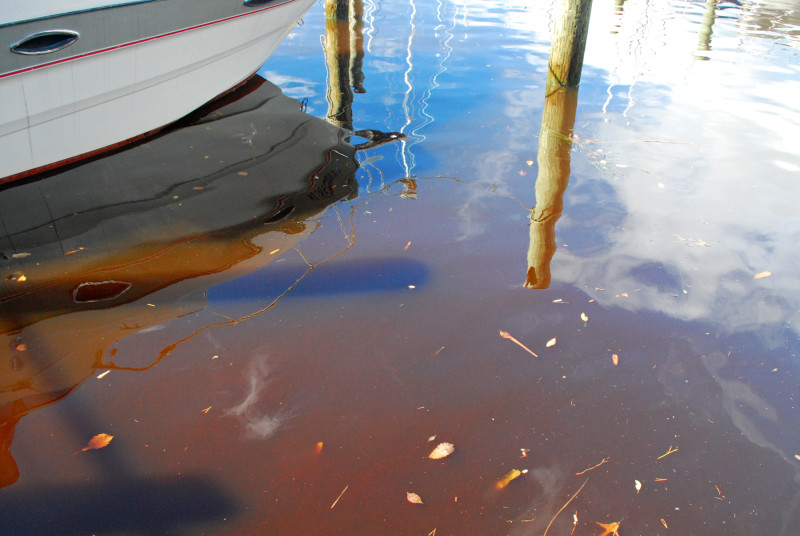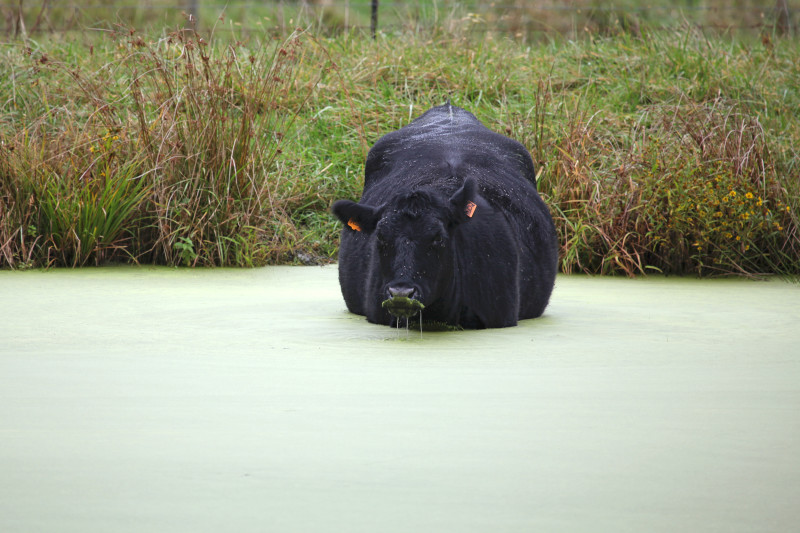Lessons from the Chesapeake: How groundbreaking restoration plans for this southern water body may help save Buzzards Bay
Four hundred miles south of Buzzards Bay lies a waterway whose story is similar to our own Bay in many ways. Although the Chesapeake Bay’s scale is bigger, its solutions, struggles, and recent victories offer many lessons for Buzzards Bay and other coastal waterways working to combat nitrogen pollution.

Nutrient-fueled algae blooms like this “mahogany tide” are a common sight in the Chesapeake Bay during warmer months. (Image: Chesapeake Bay Program)
The Chesapeake Bay watershed – the area of land that drains to the Chesapeake Bay – covers a staggering 64,000 square miles, encompassing six states and the District of Columbia. More than 17 million people call this region their home. The Chesapeake Bay is overloaded with nutrients coming from farms, lawns, roads, wastewater, and the air.
For decades, scientists and politicians have been working to restore this national treasure. But progress has been hampered by continued development, population growth, irregular weather patterns, and weak restoration plans that hinged on promoting voluntary efforts instead of implementing stronger environmental regulations.
The Chesapeake Bay’s pollution problems may feel huge, complicated, and far away. But the people there are working to find solutions that places like Buzzards Bay may use to achieve progress to protect and restore our Bay and its coves, rivers, and harbors.
Like the Buzzards Bay Coalition here, the Chesapeake Bay has many supporters who work every day to restore and protect its health. The largest-such organization is the Chesapeake Bay Foundation, which sued the federal government in 2009 to establish a cleanup plan for the Chesapeake called a TMDL, or a total maximum daily load. TMDLs are sometimes called “pollution diets” because, much like a person cuts calories to lose weight, these government-issued cleanup plans set limits on the amount of nutrients a polluted waterway can receive.

A cow wades into an algae-covered pond in West Virginia, part of the Chesapeake Bay watershed. Agriculture is a major source of nutrient pollution to the Chesapeake Bay. (Image: Chesapeake Bay Program)
The stringent Chesapeake Bay TMDL, established in 2010 by the U.S. Environmental Protection Agency, finally set the Chesapeake on a regulatory path toward recovery. By 2025, each state is required to put into place pollution-reducing practices that would reduce nutrient pollution to the limits set in the TMDL.
TMDLs are an essential tool for cleaning up our waterways. By setting limits on nitrogen, TMDLs can both force existing polluters to cut back to lower levels and stop new sources of pollution from causing further damage to rivers, harbors, and bays.
Just last fall, the Chesapeake Bay TMDL secured a victory in court after being challenged by industry groups. In an important decision that has implications across the country, a federal court ruled that the EPA has the authority under the Clean Water Act to establish the TMDL required to clean up the Chesapeake. Although the Chesapeake Bay is still far from restored, the dream that children there will grow up to inherit clean, clear water is now closer than ever.
The Chesapeake is our nation’s laboratory for both solving the nitrogen pollution problem and testing the legal limits of the federal Clean Water Act to address difficult “nonpoint” sources of pollution such as septic systems, fertilizers, and road runoff. Though far away, the groundbreaking work our friends to the south are achieving will play a big role in the cleanup of our own irreplaceable Buzzards Bay.